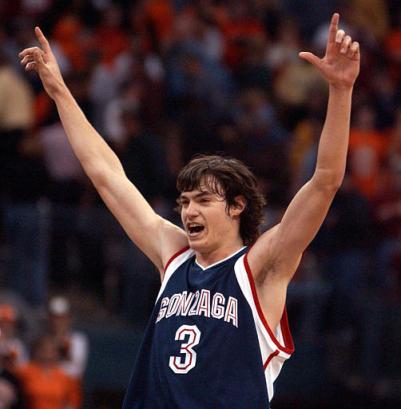
2010: All Stars from small markets: LeBron James (Cleveland); Al Hordford (Atlanta); Chris Bosh (Toronto) Gerald Wallace (Charlotte); Joe Johnson (Atlanta); Carmelo Anthony (Denver); Steve Nash (Phoenix); Kevin Durant (Oklahoma City); Zach Randolph (Memphis); Chris Paul (New Orleans); Chauncey Billups (Denver); Brandon Roy (Portland); Deron Williams (Utah)
2011 All Stars from small markets: Al Hordford (Atlanta); Joe Johnson (Atlanta); Kevin Durant (Oklahoma City); Chris Paul (New Orleans); Kevin Love (Minnesota); Russell Westbrook (Oklahoma City)
In the last year, LeBron James, Chris Bosh, Carmelo Anthony, Chauncey Billups, and Deron Williams have all fled to the big city. That’s a remarkable amount of talent, especially when you consider that many of the small market all Stars who have stayed put did so because they simply didn’t have the opportunity to leave. You can blame the exodus on the lust for fame and money, but like most things in life, I prefer to blame it on the Boston Celtics and LeBron James.
For years, traditional knowledge was that to build a championship you need one superstar, one really good player, and two to three role players. Take arguably the best team in NBA history the 1995-1996 bulls: Jordan (superstar), Pippen (really good player), Rodman (rebounder), Kukoc (3 point shooter). Just about every really great team in the last 25 years followed this build. Think about all the good 2 player combos: Stockton and Malone, Shaq and young Kobe, Duncan and Parker, the list goes on and on.
The glaring exception to this pattern is the 2008 Boston Celtics. Boston took three superstars who were thirsty for a title and put them on the same team. The result was marvelous. The big three not only wound up beating a very good Lakers team in the championship, but were part of the greatest turnaround in NBA history. The 2008 Celtics improved by a whopping forty two games better than the 2007 squad. To put the turnaround in perspective, it would be the equivalent of the New Jersey Nets winning the championship next year.
Despite the dramatic turnaround people the league didn’t think that the 3 superstar approach was a tenable approach to building a team. Boston hit a lot of luck (pun intended) in building its team. Not only did it pick up guys willing to work for less, but their role players turned out to be better than anyone could have expected. (Show me someone who says they foresaw Rondo turning into an All Star and I will show you a liar.) The traditional belief remained that in order to build a championship team your best bet is to follow traditional build. The 2009 and 20010 Lakers only confirmed this belief as they had one superstar (Kobe), one really good player (Gasol), and three role players (Artest, Odom, and Fisher).
Perhaps the world would have remained the same if it wasn’t for the infamous “Decision.” The unholy union of James, Bosh and Wade has dramatically changed the way we look at building a team in two ways. First, the success of the three superstars with absolutely no supporting cast weakens the traditional understanding that role players are incredibly important. Second, the traditional belief that it would be logistically and financially impossible to get three superstars to want to play on the same team has been proven false.
As a result the big market teams are now greedier than ever. The Knicks have Stodamire and Carmelo and are supposedly trying to lure in Paul. The Lakers have Kobe and Gasol and are supposedly hoping to land Howard
In theory, the rise of the super-team shouldn’t automatically spell the destruction of the smaller markets. In theory Denver could also sign three superstars and be competitive; however in reality they can’t. No disrespect to smaller cities but they cannot attract that much talent. If you don’t believe me ask Deron Williams who unsuccessfully tried to recruit players to play on the Jazz with him. Ask Atlanta who had to make Joe Johnson this summer’s highest paid free agent just to keep him from bolting.
The second reason why small markets can’t get three superstars is that they simply cannot afford it. The NBA’s soft cap allows NBA owners to exceed the cap so long as they are willing to pay the luxury tax. For Jerry Buss and the Lakers, paying the luxury tax is not an issue, but going over the cap would be the death knell for the Charlotte Bobcats. The Lakers pull in almost three times more from their gate receipts than the Bobcats.
Not withstanding, all may not be lost for those smaller markets that cannot create a super-team. First, we are not sure if the super-team experiment will actually work. There are still a lot of very good teams who follow the traditional model who can win this year including the Lakers, the Spurs, and Bulls. The majority of experts still believe that you cannot win a championship without bona-fide role players.
Perhaps more importantly, “The Decision” occurred right before the next collective bargaining agreement. Small market owners are gearing up to fight for a hard salary cap, a franchise tag, and anything they can get to restore parity to the league. It may seem far-fetched, but the current rise of the Super-team may actually result in more parity in the long run.





